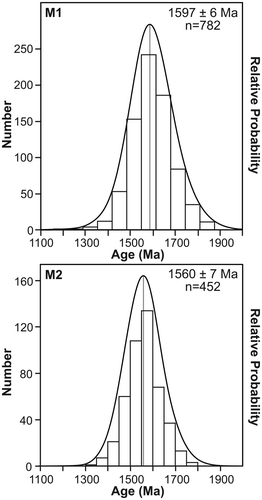Figures & data
Figure 1 Location of the southern Curnamona Province in northeastern South Australia and western New South Wales. Boxed area shows sample localities ( ).

Figure 2 Position of Australia relative to Laurentia for the SWEAT and AUSWUS tectonic reconstruction models (modified from Karlstrom et al. 2001).
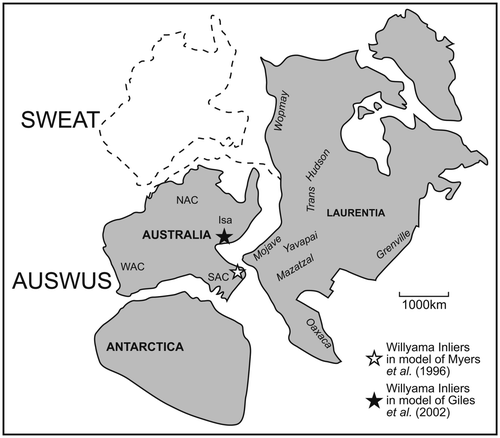
Figure 3 Palaeoproterozoic and Mesoproterozoic tectonostratigraphic history of the southern Curnamona Province highlighting the timing of deposition of the Willyama Supergroup, timing of major magmatic events, and the proposed timing of tectonometamorphic events prior to this study. Data sources: Ludwig and Cooper (Citation1984), Page and Laing (Citation1992), Ashley et al. (Citation1996), Nutman and Ehlers (Citation1998), Page et al. (Citation1998, Citation2000, Citation2003, Citation2005a, Citationb), Barovich and Hand (Citation2004), Gibson and Nutman (Citation2004).
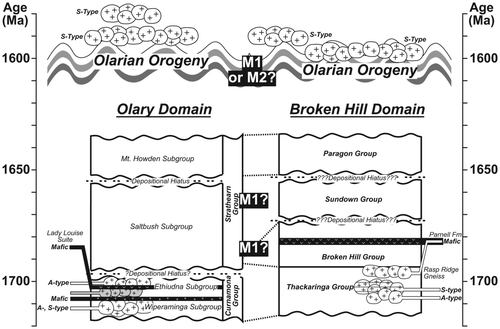
Figure 4 Proterozoic tectonic reconstruction highlighting the proximity of the Willyama basin to the Maronan basin in northern Australia prior to the 55° rotation of the southern Australian craton proposed by Giles et al. (Citation2002). Both basins are situated in the backarc to convergent margins at the southern and eastern margins of the North Australian Craton (after Giles et al. Citation2002).

Table 1 Summary of monazite chemical age data from samples analysed in this study: distinction made between different occluding phases and the mean chemical ages of monazite included in these phases.
Figure 5 Regional geological map of the southern Curnamona Province showing the distribution of lithological units (Jenkins & Burtt Citation2003), and sample localities indicated by filled circles with sample numbers/letters.
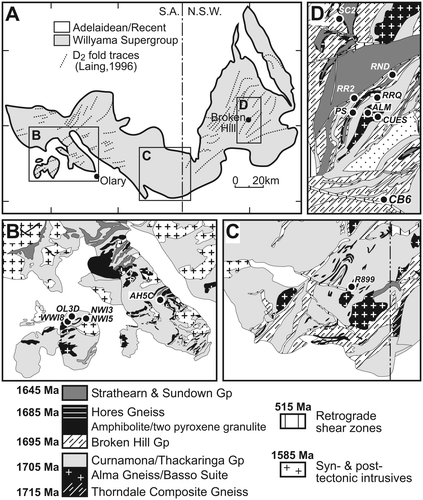
Figure 6 Pre-peak to syn-peak metamorphic monazite-hosting lithologies (M1). (a) Photomicrograph of andalusite – garnet – staurolite – mica metapelitic schist (NWI5), cross-polarised light (XPL). (b) Backscatter electron (BSE) images of monazite occluded by synkinematic andalusite in sample NWI5. (c) Photomicrograph of garnet – fibrolite – biotite – muscovite – chloritoid metapeltic schist (AH5C), plane-polarised light (PPL). (d) BSE image of monazite in AH5C. Monazite occurs as clusters in fractures dissecting the core of a polymetamorphic garnet. (e) Qualitative elemental maps (Fe, Ca) of polymetamorphic garnets from AH5C. (f) Photomicrograph of garnet – sillimanite – cordierite – mica metapelitic gneiss (RND), PPL. (g) BSE image of monazite in sample RND. (h) Photomicrograph of garnet – sillimanite – fibrolite – mica metapelitic schist (SC2), PPL. (i) BSE image of monazite occluded within matrix micas defining post-kinematic fabric (S2). (j) Photomicrograph of garnet – sillimanite – biotite – muscovite metapelitic gneiss (PS), PPL. (k) BSE images of monazite occluded within the mica matrix of sample PS; monazite rims replaced by apatite – allanite coronas. (l) Photomicrograph of andalusite – garnet – staurolite – mica metapelitic unit (NWI3), XPL. (m) BSE image of monazite occluded within a partly retrogressed andalusite porphyroblast from sample NWI3. (n) Photomicrograph of plagioclase – quartz – biotite – garnet granitic gneiss (RRQ), XPL; monazite occluded within the fractured garnet porphyroblasts. (o) Photomicrograph of sillimanite – quartz – feldspar – garnet – biotite gneiss (ALM), XPL; monazite occluded by plagioclase and sillimanite. (p) BSE image of garnet – cordierite – sillimanite – feldspar – biotite gneissic metapelitic gneiss (CUES); monazite occluded within all major silicate phases. (q) Qualitative elemental map of Mg in garnet – cordierite decompression texture from sample CUES. Mineral abbreviations: allan, allanite; and, andalusite; apa, apatite; bt, biotite; cd, cordierite; chl, chlorite; fib, fibrolite; gt, garnet; ilm, ilmenite; Ksp, K-feldspar; mu, muscovite; mz, monazite; pl, plagioclase; q, quartz; ser, sericite; sill, sillimanite; st, staurolite.
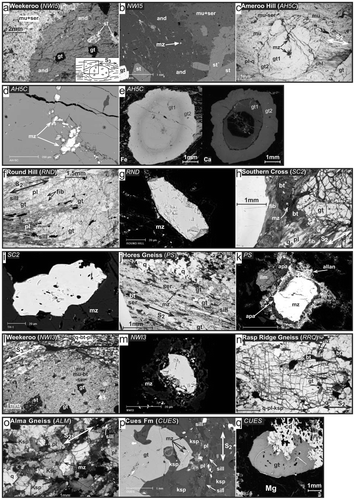
Figure 7 Post-peak Olarian metamorphic monazite-bearing lithologies (M2). (a) Photomicrograph of quartz – feldspar – biotite granitic gneiss (Rasp Ridge Gneiss; RR2), plane-polarised light (PPL). (b) Backscatter electron (BSE) image of monazite occluded by plagioclase in sample RR2. (c) BSE image of garnet – sillimanite – biotite – feldspar – quartz metapelitic granulite (R899). (d) BSE image of monazite occluded within matrix biotite in sample R899. (e) Photomicrograph of mica – magnetite – quartz lithology (CB6), cross-polarised light (XPL). (f) BSE image of monazite located at quartz triple point in sample CB6. (g) Photomicrograph of retrograde garnet – muscovite – sericite schist (WW18), PPL.(h) BSE image of monazite analysed from within the retrograde matrix in sample WW18. (i) Photomicrograph of retrograde chlorite – sericite – muscovite – biotite schist (OL3D), PPL; monazite analysed from within strongly foliated matrix. Mineral abbreviations listed in .
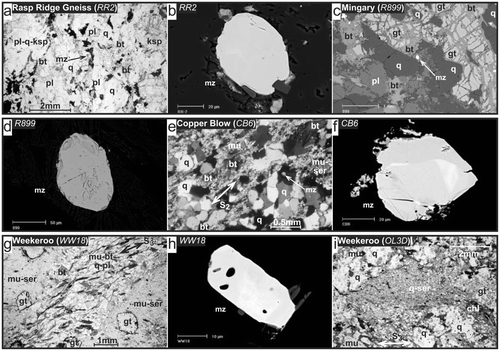
Figure 8 Probability density plots of all monazite chemical ages pooled together with regard to the two metamorphic events identified in this study.
